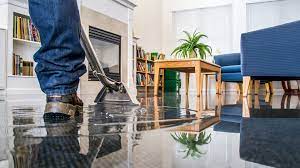Water damage can strike any property without warning, whether due to heavy storms, plumbing failures, or simple accidents. When it happens, quick and professional action is crucial to minimize destruction and restore your home or business to its original condition. In this guide, we’ll walk you through the essential steps of the water damage restoration process – and show you why trusting experts like EZ Water Restoration makes all the difference.
Understanding Water Damage
Water damage can range from minor leaks to major flooding events. It’s typically classified into three categories:
- Clean water from broken pipes or rainwater.
- Grey water from appliances like dishwashers or washing machines.
- Black water, which is highly contaminated, such as sewage backups.
Each type poses different risks and requires specific handling to protect both your property and your health.
The Importance of Immediate Action
The longer water sits, the worse the damage becomes. Mold can begin to develop within 24–48 hours, and structural elements like wood and drywall can start to deteriorate quickly. Immediate professional intervention helps save materials, lower restoration costs, and ensure a safer environment.
Step 1: Inspection and Assessment
The first step in water damage restoration is a thorough inspection. Trained technicians assess the extent of the damage using moisture detectors and infrared cameras. This initial evaluation forms the basis of a customized restoration plan.
Step 2: Water Extraction
Removing standing water is critical to prevent further deterioration. High-powered pumps and vacuum units are used to quickly extract hundreds or even thousands of gallons of water. Immediate extraction reduces drying time and helps prevent mold growth.
Step 3: Drying and Dehumidification
Even after visible water is removed, moisture can remain hidden inside walls, floors, and furniture. Industrial-grade dehumidifiers and air movers are used to thoroughly dry the affected areas. Proper drying is essential to prevent long-term structural issues and health hazards like mold infestations.
Step 4: Cleaning and Sanitizing
Water damage often brings contaminants that must be properly cleaned. Restoration professionals use specialized cleaning products and antimicrobial treatments to sanitize surfaces and belongings. This step ensures your home or business is safe and habitable again.
Step 5: Restoration and Repair
The final stage is restoring your property to its pre-damage condition. Depending on the extent of the damage, this might include minor repairs like drywall patching or major reconstruction projects such as replacing entire rooms. Restoration experts ensure the finished work not only looks good but is structurally sound and built to last.
Step 6: Preventing Future Water Damage
An important part of the restoration process is helping homeowners and business owners understand how to prevent future water issues. Regular inspections, maintaining plumbing systems, ensuring proper drainage around the property, and investing in storm damage mitigation measures can significantly reduce risks.
Water damage can be a nightmare, but with the right knowledge and professional support, it doesn’t have to be. Acting quickly is key to minimizing loss and ensuring a smooth recovery process. If you find yourself facing water damage, don’t hesitate to contact the certified team atEZ Water Restoration for fast, reliable, and compassionatewater damage restoration services. Protect your property – and your peace of mind – with experts who care.







